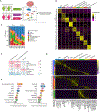Myeloid Cell-associated Resistance to PD-1/PD-L1 Blockade in Urothelial Cancer Revealed Through Bulk and Single-cell RNA Sequencing
- PMID: 33837006
- PMCID: PMC8338756
- DOI: 10.1158/1078-0432.CCR-20-4574
Myeloid Cell-associated Resistance to PD-1/PD-L1 Blockade in Urothelial Cancer Revealed Through Bulk and Single-cell RNA Sequencing
Abstract
Purpose: To define dominant molecular and cellular features associated with PD-1/PD-L1 blockade resistance in metastatic urothelial cancer.
Experimental design: We pursued an unbiased approach using bulk RNA sequencing data from two clinical trials to discover (IMvigor 210) and validate (CheckMate 275) pretreatment molecular features associated with resistance to PD-1/PD-L1 blockade in metastatic urothelial cancer. We then generated single-cell RNA sequencing (scRNA-seq) data from muscle-invasive bladder cancer specimens to dissect the cellular composition underlying the identified gene signatures.
Results: We identified an adaptive immune response gene signature associated with response and a protumorigenic inflammation gene signature associated with resistance to PD-1/PD-L1 blockade. The adaptive immune response:protumorigenic inflammation signature expression ratio, coined the 2IR score, best correlated with clinical outcomes, and was externally validated. Mapping these bulk gene signatures onto scRNA-seq data uncovered their underlying cellular diversity, with prominent expression of the protumorigenic inflammation signature by myeloid phagocytic cells. However, heterogeneity in expression of adaptive immune and protumorigenic inflammation genes was observed among single myeloid phagocytic cells, quantified as the myeloid single cell immune:protumorigenic inflammation ratio (Msc2IR) score. Single myeloid phagocytic cells with low Msc2IR scores demonstrated upregulation of proinflammatory cytokines/chemokines and downregulation of antigen presentation genes, were unrelated to M1 versus M2 polarization, and were enriched in pretreatment blood samples from patients with PD-L1 blockade-resistant metastatic urothelial cancer.
Conclusions: The balance of adaptive immunity and protumorigenic inflammation in individual tumor microenvironments is associated with PD-1/PD-L1 resistance in urothelial cancer with the latter linked to a proinflammatory cellular state of myeloid phagocytic cells detectable in tumor and blood.See related commentary by Drake, p. 4139.
©2021 American Association for Cancer Research.
Figures






Comment in
-
Myeloid Resistance is not Futile: Biomarkers of Immunotherapy in Bladder Cancer.Clin Cancer Res. 2021 Aug 1;27(15):4139-4141. doi: 10.1158/1078-0432.CCR-21-1011. Epub 2021 May 27. Clin Cancer Res. 2021. PMID: 34045294
-
Urologic Oncology: Bladder, Penis, and Urethral Cancer, and Basic Principles of Oncology.J Urol. 2023 Jul;210(1):217-218. doi: 10.1097/JU.0000000000003465. Epub 2023 Apr 27. J Urol. 2023. PMID: 37102734 No abstract available.
References
-
- Sharma P, Retz M, Siefker-Radtke A, et al. Nivolumab in metastatic urothelial carcinoma after platinum therapy (CheckMate 275): a multicentre, single-arm, phase 2 trial. Lancet Oncol 2017;18(3). - PubMed
Publication types
MeSH terms
Substances
Grants and funding
LinkOut - more resources
Full Text Sources
Other Literature Sources
Medical
Research Materials

